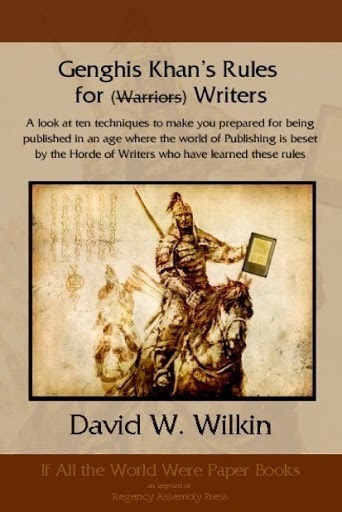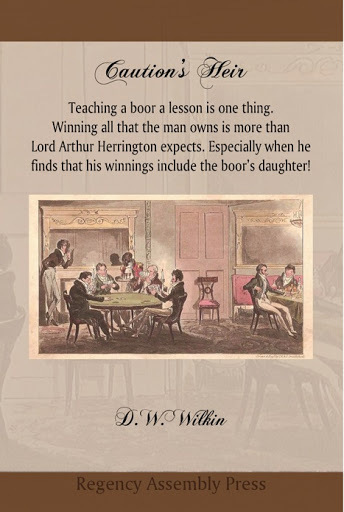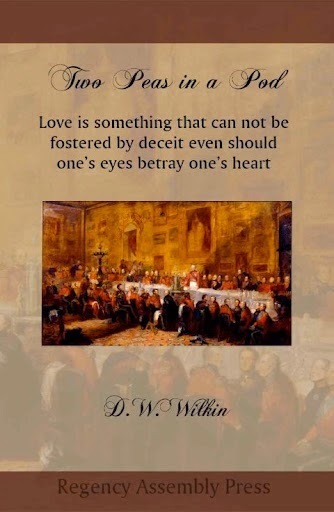D.W. Wilkin's Blog, page 182
September 15, 2014
Rules for better writing from Genghis Khan
The Rules for Writers
Those who follow me for a long time know that I also write in other fields aside from Regency Romance and the historical novels I do.
A little while ago, before the end of 2011 and the 2011 NaNoWriMo, (where I wrote the first draft of another Regency) I started work on a project about writing.
The premise was what one should think about when starting and working on a project. I came up with 10 rules to follow in a quest to become a writer and tackle that novel.
Here are The 10 Rules:
1) Read like a writer
2) Have a good story
3) Your work will be Thematic
4) Plot: The seven deadly ones
5) Characters will carry your tale, near and far
6) Words are your warriors
7) Stories are structured
8) All tales building to a Crescendo
9) Genghis edits history, shouldn’t you as well
10) Act like a writer
So it is now released. For $4.99 you can get this treatise on honing your skills.
Barnes and Noble for your Nook
Genghis Khan came from the Steppes of Mongolia, a family torn apart by neighboring tribes, to unite those tribes, or defeat them, and then conquer the greater part of the known world. His heirs would continue his conquest right to the edge of western society. The world feared the Mongols, and Genghis. Now, you can benefit, as a writer from the lessons he has to impart on how, with the changing world of publishing, you can perfect your work and write not only good material for this new age of book publishing. But can write great work for this new age. 10 simple lessons, and you will be on your way to conquering the bookshelves of the 21st century. This short book will have you learning all you really need to know to elevate your writing to the next level. These simple lessons will start you on the road to better writing as a member of the Horde in no time.
Feedback
If you have any commentary, thoughts, ideas about the book (especially if you buy it, read it and like it ;-) then we would love to hear from you.


September 14, 2014
RAP is now looking for Cover and Interior artists-Can you draw like CE Brock?
Are you an Artist?
Now editing the final draft of another of our romance stories, we have started to lean to the idea that perhaps a professional artist might be better than our own renditions. Someone who can bring out the details and bring our stories alive.
If anyone knows of someone who would like to discuss designing a cover for RAP or the interiors (we think that a facing illustration at the start of every chapter like in the early part of the last century would be splendid), please get in contact with us.
In the immediate future we plan to launch a Kickstarter and wish to contract out the cover art and interior illustrations. Should we be funded in this project, you will be paid for your work immediately.
Our many works, one of the things we would like to see is having pen & ink or pencil illustrations at the beginning of each chapter. Can you draw like CE Brock? He did amazing work for the books and stories of Jane Austen in the early 1900s.
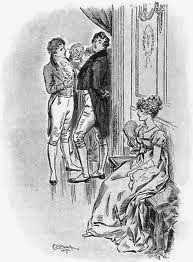
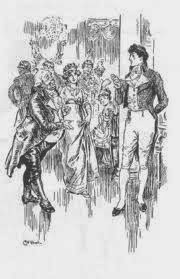


Regency Personalities Series-Thomas John Cochrane
Regency Personalities Series
In my attempts to provide us with the details of the Regency, today I continue with one of the many period notables.
Thomas John Cochrane
5 February 1789 – 19 October 1872
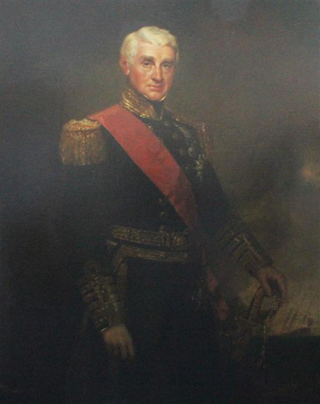
Thomas John Cochrane
Thomas John Cochrane was born to Alexander Forrester Inglis Cochrane, who had an illustrious naval career, and his wife. He was always destined to go to sea, and was entered into the navy at the age of seven.
Cochrane began his naval career in 1796 when enlisted at the age of seven and was promoted to lieutenant at the age of 16. His rise quickly in the ranks was considered by many to be blatant patronage because of his father’s influence. Cochrane first commanded HMS Forte.
When Newfoundland became an official Crown colony in 1825, Cochrane at the age of 36 was appointed as its first governor. He took his family with him to Newfoundland: his wife Matilda Lockhart-Ross and their young children Maria and Alexander.
At the time, military officers were appointed to direct colonies that did not yet have representative government. He directed the construction of Government House, which is located between Fort William and Fort Townshend. It has been designated as a National Historic Site of Canada. Although Cochrane had opposed the introduction of representative government to the colony, a new constitution was granted in 1832 and he was appointed as the first civil governor.
Cochrane had many conflicts while governor, especially with the Roman Catholic bishop, Michael Fleming. Much of the Catholic population were descendants from the years when France had been predominant in eastern Canada and included ethnic French and Irish. The colonial office recalled Cochrane in 1834, who had become unpopular. When he left, he and his daughter were pelted with filth on their way down Cochrane Street to the wharf.
He was Member of Parliament (MP) for Ipswich from 1839 to 1841.
In 1842 Cochrane was appointed as Second in Command of the East Indies and China Station before being appointed Commander-in-chief of that Station in his Flagship, HMS Agincourt in 1844. He took part in anti-piracy operations around North West Borneo, including destroying the forts at Brunei in 1845 and 1846.
In 1852 he was appointed as Commander-in-Chief, Portsmouth. He was promoted to Admiral of the Fleet in 1865.
He was knighted and received the Order of the Bath for his service in the East Indies.
Cochrane Street in St. John’s was named for him.
Cochrane Street in Hong Kong was also named for him.
In 1812 he married Matilda Lockhart-Ross. They had one daughter and one son:
Maria Theresa Cochrane, and
Alexander Dundas Ross Cochrane (1816-1890), who became a politician and MP; he was created Baron Lamington in 1880.
Sir Thomas married secondly, in 1853, Rosetta Wheler-Cuffe (1816-1901), daughter of Sir Jonah Denny Wheler-Cuffe, 1st Baronet and his wife. They had one son and one daughter:
Ann Annette “Minna” Cochrane (1855-1943), a courtier;
Thomas Belhaven Henry Cochrane (1856-1925), who became a Deputy Governor of the Isle of Wight
He lived at Hanover Lodge, Regent’s Park which had previously been owned by General Sir Robert Arbuthnot, KCB. Later Cochrane and his wife lived at Quarr Abbey House where guests included Queen Victoria.
Thomas John Cochrane died on the Isle of Wight at Quarr Abbey House, Binstead, 19 October 1872, aged 83. He is buried in the family mausoleum, plot 21777 Kensal Green Cemetery, London.
Lady Cochrane died at Quarr Abbey House, 27 May 1901. She was buried at Kensal Green Cemetery, interred in the mausoleum alongside her husband. Survivors present at her funeral included her brother Major Cuffe; her son, Lieutenant Thomas Belhaven Henry, then deputy governor of the Isle of Wight and his two daughters; and her daughter Minna Cochrane. Also attending were the servants from Quarr Abbey House.


The Weekly Regency Post
A play upon The Morning Post that was published in the Regency Era. A newspaper owned by R. Tattersall and His Royal Highness, Prince George.
This is a weekly wrap-up of posts from various sources who write regency posts brought to you on a Sunday.
Visit at The Weekly Regency Post


September 13, 2014
Regency Personalities Series-Vice Admiral Cuthbert Collingwood 1st Baron Collingwood
Regency Personalities Series
In my attempts to provide us with the details of the Regency, today I continue with one of the many period notables.
Vice Admiral Cuthbert Collingwood 1st Baron Collingwood
26 September 1748 – 7 March 1810
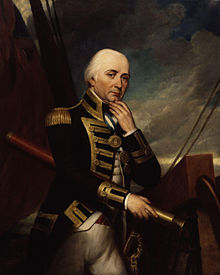
Cuthbert Collingwood
Collingwood was born in Newcastle upon Tyne. His early education was at the Royal Grammar School, Newcastle. At the age of twelve, he went to sea as a volunteer on board the frigate HMS Shannon under the command of his cousin Captain (later Admiral) Richard Brathwaite (or Braithwaite), who took charge of his nautical education. After several years of service under Captain Brathwaite and a short period attached to HMS Lenox, a guardship at Portsmouth commanded by Captain (later Admiral) Robert Roddam, Collingwood sailed to Boston in 1774 with Admiral Samuel Graves on board HMS Preston, where he fought in the British naval brigade at the battle of Bunker Hill, and was afterwards commissioned as a Lieutenant.
In 1777, Collingwood first met Nelson when both served in HMS Lowestoffe. Two years later, Collingwood succeeded Nelson as Commander (20 June 1779) of HMS Badger, and the next year he again succeeded Nelson as Post-Captain (22 March 1780) of HMS Hinchinbrook, a small frigate. Nelson had been the captain of a failed expedition to cross Central America from the Atlantic Ocean to the Pacific Ocean by navigating boats along the San Juan River, Lake Nicaragua and Lake Leon. Nelson was debilitated by disease and had to recover before being promoted to a larger vessel, and Collingwood succeeded him in command of the Hinchinbrook and brought the remainder of the expedition back to Jamaica.
After commanding in another small frigate, HMS Pelican, in which he was shipwrecked by a hurricane in 1781, Collingwood was promoted to 64 gun ship of the line HMS Sampson, and in 1783 he was appointed to HMS Mediator and posted to the West Indies, where he remained until the end of 1786, again, together with Nelson and this time his brother, Captain Wilfred Collingwood, preventing American ships from trading with the West Indies.
In 1786 Collingwood returned to England, where, with the exception of a voyage to the West Indies, he remained until 1793. In that year, he was appointed captain of HMS Prince, the flagship of Rear Admiral George Bowyer in the Channel Fleet. On 16 June 1791, Collingwood married Sarah Blackett, daughter of the Newcastle merchant and politician John Erasmus Blackett and granddaughter of Robert Roddam of Hethpoole and Caldburne (not to be confused with his former commander, later Admiral, Robert Roddam).
As captain of Barfleur, Collingwood was present at the Glorious First of June. On board the Excellent he participated in the victory of the Battle of Cape St Vincent in 1797, establishing a good reputation in the fleet for his conduct during the battle. After blockading Cadiz, he returned for a few weeks to Portsmouth to repair. At the beginning of 1799 Collingwood was raised to the rank of Rear-Admiral (of the White 14 February 1799; of the Red 1 January 1801) and, hoisting his flag in the Triumph, joined the Channel Fleet and sailed to the Mediterranean where the principal naval forces of France and Spain were assembled. Collingwood continued to be actively employed in blockading the enemy until the peace of Amiens allowed him to return to England.
With the resumption of hostilities with France in the spring of 1803 he left home, never to return. First he blockaded the French fleet off Brest. In 1804 he was promoted to Vice-Admiral (of the Blue 23 April 1804; of the Red 9 November 1805). Nearly two years were spent here but with Napoleon planning and equipping his armed forces for an invasion of Britain, the campaign which was to decide the fate of Europe and the command of the sea was starting. The French fleet having sailed from Toulon, Admiral Collingwood was appointed to command a squadron, with orders to pursue them. The combined fleets of France and Spain, after sailing to the West Indies, returned to Cadiz. On their way they encountered Collingwood’s small squadron off Cadiz. He only had three ships with him; but he succeeded in avoiding the pursuit, although chased by sixteen ships of the line. Before half of the enemy’s force had entered the harbour he resumed the blockade, using false signals to disguise the small size of his squadron. He was shortly joined by Nelson who hoped to lure the combined fleet into a major engagement.
The combined fleet sailed from Cadiz in October 1805. The Battle of Trafalgar immediately followed. Villeneuve, the French admiral, drew up his fleet in the form of a crescent. The British fleet bore down in two separate lines, the one led by Nelson in the Victory, and the other by Collingwood in the Royal Sovereign. The Royal Sovereign was the swifter sailer, mainly because its hull had been given a new layer of copper which lacked the friction of old, well used copper and thus was much faster. Having drawn considerably ahead of the rest of the fleet, it was the first engaged. “See”, said Nelson, pointing to the Royal Sovereign as she penetrated the centre of the enemy’s line, “see how that noble fellow Collingwood carries his ship into action!” Probably it was at the same moment that Collingwood, as if in response to the observation of his great commander, remarked to his captain, “What would Nelson give to be here?”
The Royal Sovereign closed with the Spanish admiral’s ship and fired her broadsides with such rapidity and precision at the Santa Ana that the Spanish ship was on the verge of sinking almost before another British ship had fired a gun. Several other vessels came to Santa Ana’s assistance and hemmed in the Royal Sovereign on all sides; the latter, after being severely damaged, was relieved by the arrival of the rest of the British squadron, but was left unable to manoeuvre. Not long afterwards the Santa Ana struck her colours. On the death of Nelson, Collingwood assumed the command-in-chief, transferring his flag to the frigate Euryalus. Knowing that a severe storm was in the offing, Nelson had intended that the fleet should anchor after the battle, but Collingwood chose not to issue such an order: many of the British ships and prizes were so damaged that they were unable to anchor, and Collingwood concentrated efforts on taking damaged vessels in tow. In the ensuing gale, many of the prizes were wrecked on the rocky shore and others were destroyed to prevent their recapture, though no British ship was lost.
On 9 November 1805 Collingwood was promoted Vice-Admiral of the Red and raised to the peerage as Baron Collingwood, of Caldburne and Hethpool in the County of Northumberland. He also received the thanks of both Houses of Parliament and was awarded a pension of £2000 per annum. Together with all the other captains and admirals, he also received a gold medal, his third, after those for the Glorious First of June and the Cape St Vincent; only Nelson and Sir Edward Berry share the distinction of three gold medals for service during the wars against France.
When not at sea he resided at Collingwood House in the town of Morpeth which lies some 15 miles north of Newcastle upon Tyne and Chirton Hall in Chirton, now a western suburb of North Shields. He is known to have remarked, “whenever I think how I am to be happy again, my thoughts carry me back to Morpeth.”
From Trafalgar until his death no great naval action was fought though several small French fleets would attempt to run the blockade, and one successfully landed troops in the Caribbean two months after Trafalgar, the majority were hunted down and overwhelmed in battle. Collingwood was occupied in important political and diplomatic transactions in the Mediterranean, in which he displayed tact and judgement. In 1805 he was appointed to the Commander-in-Chief, Mediterranean Fleet. He requested to be relieved of his command that he might return home, however the government urgently required an admiral with the experience and skill of Collingwood to remain, on the grounds that his country could not dispense with his services in the face on the still potent threat that the French and their allies could pose. His health began to decline alarmingly in 1809, and he was forced to again request the Admiralty to allow him to return home, which was finally granted. Collingwood died on board the Ville de Paris, off Port Mahon as he sailed for England, on 7 March 1810. He was laid to rest besides Nelson in the crypt of St Paul’s Cathedral.


September 12, 2014
Friday Interviews-Judith Starkston Interview
Today we are fortunate to have with us Judith Starkston who writes in the historical fiction genre.
1) What moved you to become an author?
I have always been a storyteller and that’s the essential ingredient to be an author, I think. Many years ago, I walked through the British Museum with my toddler son on my shoulders (he’s a grown man now). I was retelling the myths painted on the Greek vases in front of us. We were happily lost in our imaginative world. I turned to go to another display case and discovered a crowd behind me listening in. So I think I was “writing” historical tales for a long time before I sent a manuscript to a publisher.
2) Tell us about your current novel.
Hand of Fire  tells the story of Briseis, the captive woman from Homer’s Iliad who caused the bitter conflict between Achilles and Agamemnon. She has practically no voice in the male-centered epic; I wanted to discover her as a flesh and blood woman.
tells the story of Briseis, the captive woman from Homer’s Iliad who caused the bitter conflict between Achilles and Agamemnon. She has practically no voice in the male-centered epic; I wanted to discover her as a flesh and blood woman.
Hand of Fire is partly a romance, although definitely not a typical romance arc or style. Briseis and Achilles fall in love in an unconventional manner that includes a mystical element. Achilles is half-immortal and I made full use of that half of his conflicted personality.
In addition to the romantic element, Hand of Fire explores why some people, women especially, can survive great tragedy and violence against them, even managing to experience joy in what life still has to offer.
Hand of Fire  is also a coming of age tale featuring a smart, strong-willed young woman in an ancient culture that, counter to our modern stereotypes of the past, expects Briseis to be powerful, literate and a leader. Briseis succeeds in rising to those expectations despite the circumstances arrayed against her—and she’s strong enough to take on the mightiest of the Greek heroes.
is also a coming of age tale featuring a smart, strong-willed young woman in an ancient culture that, counter to our modern stereotypes of the past, expects Briseis to be powerful, literate and a leader. Briseis succeeds in rising to those expectations despite the circumstances arrayed against her—and she’s strong enough to take on the mightiest of the Greek heroes.
3) How did the story begin to develop in your mind?
While teaching the Iliad, I kept wondering with my students how Briseis could possibly have loved Achilles—which is what Homer shows us. The half-immortal Greek killed her husband and brothers, destroyed her city and turned her from princess to slave—hardly a heartwarming courtship. She’s central to the plot of the Iliad and yet she gets only a handful of lines. In those few words, the one clear notion expressed is her sorrow at being parted from Achilles.
I should say I always liked Achilles, the existential hero who calls the whole war into question—which shows he’s no brainwasher—so the answer wasn’t some ancient version of Stockholm Syndrome. I started exploring who Briseis could be that would solve this psychological puzzle. Who was she before Achilles entered her world and how did the tragedy and love he brought her alter her? What kind of woman can stand up to this semi-divine, but immensely conflicted man and hold onto her own sense of self, as she must have, to form a genuine bond with him?
4) What did you find most challenging about this book?
Homer only tells us a few fragments about Briseis—that she was a princess of Lyrnessos, a city allied to Troy, and that Achilles destroyed that life. Not much to base a novel on. So I had to do a great deal of research to create a historically plausible and engaging Briseis. Fortunately for me, Turkey, where Troy was located, is an extremely active region for contemporary archaeology and the last couple decades or so have revealed a rich record of the life of this area during the time of the Trojan War (the Late Bronze Age around 1250 BCE, roughly speaking).
5) How did you choose your publishing method?
Anything set in Greek history, such as the Trojan War, is considered a fairly small niche of historical fiction. After a couple well-respected agents told me they loved my manuscript but didn’t think they could sell it to a major publisher in the current market, I researched good small presses for historical fiction and chose Fireship. I do hope to prove those agents wrong about the extent of my reading public. The Trojan War is one of those iconic moments in history that never seems to lose its appeal. So far, there’s been a lovely response. I’d be happy to be represented by an agent who saw the HF market in a similar light.
6) Tell us a little about yourself?
I studied Classics in college at University of California, Santa Cruz (DWW-I was a Banana Slug for my first two years at University, and that is when I was first published both in the gaming industry and in one of UCSC’s publications. I was an avid taker of History courses though) and went on to do my graduate work in Classics at Cornell. I taught high school Latin, Humanities and English for a couple decades. I’ve had great fun traveling in Turkey, Cyprus and Greece to research this novel and the historical mystery I’m working on now. When I was a classics major, I was more focused on Greek literature and history and did not delve into archaeology all that much. It’s been a delightful revelation to meet with archaeologists at key sites and gather the juicy details of good historical fiction from the admittedly dry reading of archaeological site reports and academic papers. It turns out the part I like best as a Classicist is archaeology. It’s the raw material of historical world building for this ancient period.
7) What is your next work, and beyond that, what do you want to work on.
I’m in the middle of a historical mystery featuring the Hittite Queen Puduhepa as “sleuth.” She would be as famous as Cleopatra if she hadn’t been buried by the sands of time. Her seal is on the first extant peace treaty in history next to her foe, Pharaoh Ramses II. Now that she’s been dug out, I’ve taken her remarkable personality, which seems perfectly suited for solving mysteries, and I am writing a series. She ruled from her teens until she was at least eighty, so I think this series may outlast me.
I’m also outlining a sequel to Hand of Fire—and Briseis may just make a major move to Cyprus. It’s such a gorgeous and intriguing island, covered in Bronze Age ruins, with several qualities that make it perfect for her. But as readers of Hand of Fire will realize, Briseis has got some business to take care of nearer to home before she can travel so far away.
8) In the current work, is there an excerpt to share? Your favorite scene, a part of your life that you put into the work and think it came out exceptionally well that you would like to share.
Here’s a brief moment that reveals Briseis rather vividly:
A rage rose up in Briseis; the sound of a hundred bees filled her head. In one motion she swept the dead Greek’s sword off the ground and leapt from behind the well. Achilles’ blade flashed in the air above her. She saw his hands grasping the hilt and sensed their power, then saw his look of astonishment as she raised her blade against the blow aimed at her brother. A new, invincible strength coursed through her arms. The desire to strike—raw and terrifying—drove out her helplessness. Her blade met his. A bolt shot through her.
9) Who do you think influenced your writing, this work, and who do you think you write like
I sometimes hear Homer in my voice because I’ve spent so much time immersed there—I think the bees in the passage above are a little reminiscent of a Homeric simile although I wasn’t thinking of that at the time. I love Victorian novels and I owe some of my use of imagery to novels like Jane Eyre. I think I’ve been more directly influenced by modern historical writers like Priscilla Royal, Elizabeth Speller and Kate Quinn, to name only a tiny sample.
At one point early on in my writing journey, when I’d been told by a good critic that my dialogue wasn’t fresh, I dissected the dialogue of several contemporary writers of historical fiction set in the ancient world. I think Kelli Stanley’s Romans  helped me understand best how to indicate social standing and other key things via dialogue without exercising a heavy hand. It’s not like these characters spoke English to begin with, so there’s a tricky balance of several issues including anachronisms versus sounding stiff and “olde.” I couldn’t have worked it all out without a number of excellent models.
helped me understand best how to indicate social standing and other key things via dialogue without exercising a heavy hand. It’s not like these characters spoke English to begin with, so there’s a tricky balance of several issues including anachronisms versus sounding stiff and “olde.” I couldn’t have worked it all out without a number of excellent models.
10) Who do you read? What are the things that a reader can identify with that you have grounded yourself in?
I’ve identified much of this in the answer above, but I’ll add to that list:  Sharon Kay Penman, (DWW- Her Sunne in Splendour is my very favorite Historical Novel of all time and I would say increased the need and desire for me to become a writer.) P.D. James, Ellen Feldman, Rhys Bowen, Rebecca Cantrell, Nancy Bilyeau, Geraldine Brooks, Jacqueline Winspear (David W Wilkin-Ms Winspear recently appeared on my radar…), Alice McDermott and Isabel Allende. Definitely not an all-inclusive list. I can already think of people I’ve left out, but I’ll carry on.
Sharon Kay Penman, (DWW- Her Sunne in Splendour is my very favorite Historical Novel of all time and I would say increased the need and desire for me to become a writer.) P.D. James, Ellen Feldman, Rhys Bowen, Rebecca Cantrell, Nancy Bilyeau, Geraldine Brooks, Jacqueline Winspear (David W Wilkin-Ms Winspear recently appeared on my radar…), Alice McDermott and Isabel Allende. Definitely not an all-inclusive list. I can already think of people I’ve left out, but I’ll carry on.
11) When writing, what is your routine?
I try to write in the early mornings when I’m fresh and leave afternoons for marketing, reviewing and blogging. I’ve never been a late night worker. With the second book, I’ve started using Scrivener, a program for writers, and it helps a great deal. (DWW-This can be found at the Literature and Latte site and it is good for all types of writing. I use it for all my stories as well. I love that I can have on the page I am working on, in my lower right corner, a list of all my Dramatis Personae. I forget who is who while writing.) In a single glance I can see the pattern of my book and choose where I want to be working. It’s much more efficient than blindly plodding along and much more fun. I couldn’t have used this program when I was learning the craft early on, but now that I have a reasonable grounding, it’s great.
12) Do you think of yourself as an artist, or as a craftsman, a blend of both?
There is a sort of otherworldly feel to writing sometimes. I find as my characters grow they begin to take on a life of their own. I heard an author a few weeks ago say he thought he connected into some writers’ version of the collection unconscious with his characters. That makes sense to me because they certainly come alive in ways that I don’t always feel in control of. They have a tendency to boss me around and tell me that they would never say or do something like that so I should get to it and rewrite that idiotic scene.
Then, there’s a great deal of hard work and learning the skills that is definitely a craft. Studying those who have done it well makes a big difference. Workshops, classes and writing-craft books help also. A pleasantly vicious critique group or groups is essential.
I taught art history in my humanities classes for too long to feel comfortable applying a word like artist to what I do—sounds like I think I belong up there with Rembrandt or Shakespeare—but there’s definitely something bigger than me going on, thank goodness!
13) Where should we look for your work?
You can connect with Judith Starkston on
Her website http://www.judithstarkston.com/
Facebook https://www.facebook.com/judy.starkston
Twitter https://twitter.com/JudithStarkston


Space Opera Books Presents A Trolling We Will Go Omnibus:The Latter Years
A Trolling We Will Go Omnibus:The Latter Years
Not only do I write Regency and Romance, but I also have delved into Fantasy.
The Trolling series, is the story of a man, Humphrey. We meet him as he has left youth and become a man with a man’s responsibilities. He is a woodcutter for a small village. It is a living, but it is not necessarily a great living. It does give him strength, muscles.
We follow him in a series of stories that encompass the stages of life. We see him when he starts his family, when he has older sons and the father son dynamic is tested.
We see him when his children begin to marry and have children, and at the end of his life when those he has loved, and those who were his friends proceed him over the threshold into death.
All this while he serves a kingdom troubled by monsters. Troubles that he and his friends will learn to deal with and rectify.
Here are the last two books together as one longer novel.
Trolling, Trolling, Trolling Fly Hides! and We’ll All Go a Trolling.
Available in a variety of formats.
For $5.99 you can get this fantasy adventure.
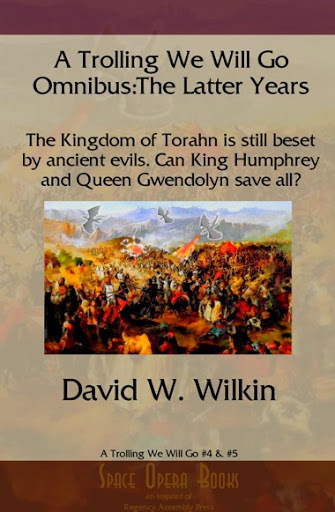
Barnes and Noble for your Nook
The stories of Humphrey and Gwendolyn. Published separately in: Trolling, Trolling, Trolling Fly Hides! and We’ll All Go a Trolling. These are the tales of how a simple Woodcutter who became a king and an overly educated girl who became his queen helped save the kingdom of Torahn from an ancient evil. Now with the aid of their children and their grandchildren.
Long forgotten is the way to fight the Trolls. Beasts that breed faster than rabbits it seems, and when they decide to migrate to the lands of humans, their seeming invulnerability spell doom for all in the kingdom of Torahn. Not only Torahn but all the human kingdoms that border the great mountains that divide the continent.
The Kingdom of Torahn has settled down to peace, but the many years of war to acheive that peace has seen to changes in the nearby Teantellen Mountains. Always when you think the Trolls have also sought peace, you are fooled for now, forced by Dragons at the highest peaks, the Trolls are marching again.
Now Humphrey is old, too old to lead and must pass these cares to his sons. Will they be as able as he always has been. He can advise, but he does not have the strength he used to have. Nor does Gwendolyn back in the Capital. Here are tales of how leaders we know and are familiar with must learn to trust the next generation to come.
Feedback
If you have any commentary, thoughts, ideas about the book (especially if you buy it, read it and like it ;-) then we would love to hear from you.


September 11, 2014
Regency Personalities Series-Thomas Sandby
Regency Personalities Series
In my attempts to provide us with the details of the Regency, today I continue with one of the many period notables.
Thomas Sandby
1721 – 25 June 1798
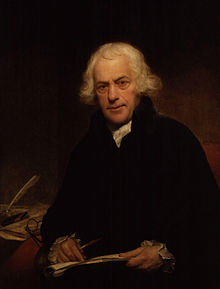
Thomas Sandby
Sandby was born in Nottingham, the son of Thomas Sandby, a textile worker, and was self-taught as a draughtsman and architect. Paul Sandby was his brother.
According to architect James Gandon’s autobiography, Thomas and his brother Paul ran a drawing academy in Nottingham before they came up to London in 1741, in order to take up employment in the military drawing department at the Tower of London (a post procured for them by John Plumptre, MP for Nottingham). Another source says that Thomas initially came to London for the purpose of having one of his pictures – a view of Nottingham – engraved.
In 1743 Sandby was appointed private secretary and draughtsman to William Augustus, Duke of Cumberland, and accompanied him in his campaigns in Flanders and Scotland (1743–1748). Sandby was at the battle of Dettingen in 1743. Pasquin says that he was appointed draughtsman to the chief engineer of Scotland, in which capacity he was at Fort William in the highlands when the Young Pretender landed, and was the first person to convey intelligence of the event to the government in 1745.
Sandby accompanied the Duke of Cumberland in his expeditions against the rebels, and made a sketch of the battle of Culloden, together with three panoramic views of Fort Augustus and the surrounding scenery, showing the encampments, in 1746, and a drawing of the triumphal arch erected in St. James’s Park to commemorate the victories. In this year the Duke was appointed ranger of Windsor Great Park, and selected Sandby to be deputy ranger; but Sandby again accompanied the duke to the Netherlands during the War of the Austrian Succession, and probably remained there till the conclusion of the Treaty of Aix-la-Chapelle in October 1748. He drew four views of the camps in the Low Countries, covering extensive tracts of country, and another inscribed ‘Abbaye près de Sarlouis’.
Sandby continued to draw a salary from the Board of Ordnance, and this, together with his appointment as deputy ranger of Windsor Great Park, which he held till his death, placed Sandby in a position of independence, and afforded scope for his talent both as an artist and as an architect. The Great Lodge (now known as Cumberland Lodge) was enlarged under his supervision as a residence for the Duke. The lower lodge was occupied by himself. His time was now principally spent in extensive alterations of the park, and in the formation of the Virginia Water Lake, in which he was assisted by his younger brother, Paul, who came to live with him. In 1754, Thomas made 8 drawings of the lake which were engraved on copper by Paul Sandby and other engravers and dedicated to the Duke of Cumberland. They were republished by John Boydell in 1772. George III, who took great interest in the undertaking, honoured Sandby with his confidence and personal friendship, and on the death of the Duke of Cumberland, in 1765, the king’s brother, Henry Frederick (also Duke of Cumberland, and ranger of the park), retained Sandby as deputy.
Although devoted to his work at Windsor and preferring a retired life, it was Sandby’s custom to spend a portion of each year in London. He rented a house in Great Marlborough Street from 1760 to 1766. He was on the committee of the St. Martin’s Lane Academy, which issued a pamphlet in 1755 proposing the formation of an academy of art, and he exhibited drawings at the Society of Artists’ exhibition in 1767, and afterwards for some years at the Royal Academy. Both he and his brother Paul were among the twenty-eight of the original members of the Royal Academy who were nominated by George III in 1768. He was elected the first professor of architecture to the academy, and delivered the first of a series of six lectures in that capacity on 8 October 1770. He continued these lectures with alterations and additions annually till his death. They were never published, but the manuscripts were held in the library of the Royal Institute of British Architects. The illustrations were sold with his other drawings after his death.
In February 1769 he entered a competition to design the Royal Exchange at Dublin, winning third prize of 40 pounds. Perhaps Sandby’s most notable architectural commission was the design of the (first) Freemason’s Hall at Great Queen Street in central London, linking two houses purchased by the United Grand Lodge of England (the Hall was extended in the 1820s by Sir John Soane, but was demolished in 1930 after suffering irreparable structural damage in a fire in 1883). The building was opened with great ceremony on 23 May 1776, when the title of ‘Grand Architect’ was conferred on him by the Freemasons.
Sandby designed a carved oak altar-screen for St. George’s Chapel, Windsor Castle, and a stone bridge over the Thames at Staines, opened in 1796, but removed a few years afterwards on account of its insecurity. He built several houses in the neighbourhood of Windsor, including St Leonard’s Hill for the Duchess of Gloucester, and one for a Colonel Deacon, later known as “Holly Grove”. Designs exist for many others of his architectural works which cannot now be identified. In 1777 he was appointed, jointly with James Adam, architect of his majesty’s works, and in 1780 master-carpenter of the his majesty’s works in England.
Sandby died at the deputy ranger’s lodge in Windsor Park on Monday, 25 June 1798. He was buried in the churchyard of Old Windsor.
Sandby was twice married. The name of his first wife is stated to have been Schultz. His second wife was Elizabeth Venables, to whom he was married in 1753. She had a dowry of 2,000 pounds, and bore him ten children, six of whom (five daughters and one son) survived him. In his will, and in some simple verses addressed to his daughters after their mother’s death, he named only 4 daughters, Harriott, Charlotte, Maria, and Ann, omitting his eldest girl, Elizabeth, who was twice married, and is said to have died about 1809. His daughter Harriott married (1786) Thomas Paul, the second son of his brother Paul, and kept house for her father after her mother’s death.
Though he was self-educated as an architect, and left few buildings by which his capacity can be tested, the hall of the freemasons shows no ordinary taste, while of his skill as an engineer and landscape-gardener Windsor Great Park and Virginia Water are a permanent record. He was an excellent and versatile draughtsman, and so skilful in the use of watercolour that his name deserves to be associated with that of his brother Paul in the history of that branch of art.


Caution’s Heir from Regency Assembly Press-Now available everywhere!
Caution’s Heir is now available at all our internet retailers and also in physical form as well
The Trade Paperback version is now available for purchase here @ $15.99 (but as of this writing, it looks like Amazon has still discounted it 10%)
Caution’s Heir is also available digitally for $4.99 @ the iBookstore, Amazon, Barnes and Noble, Kobo and Smashwords.
The image for the cover is a Cruikshank, A Game of Whist; Tom & Jerry among the ‘Swell Broad Coves.’ Tom and Jerry was a very popular series of stories at the time.
Teaching a boor a lesson is one thing.
Winning all that the man owns is more than Lord Arthur Herrington expects. Especially when he finds that his winnings include the boor’s daughter!
The Duke of Northampshire spent fortunes in his youth. The reality of which his son, Arthur the Earl of Daventry, learns all too well when sent off to school with nothing in his pocket. Learning to fill that pocket leads him on a road to frugality and his becoming a sober man of Town. A sober but very much respected member of the Ton.
Lady Louisa Booth did not have much hope for her father, known in the country for his profligate ways. Yet when the man inherited her gallant uncle’s title and wealth, she hoped he would reform. Alas, that was not to be the case.
When she learned everything was lost, including her beloved home, she made it her purpose to ensure that Lord Arthur was not indifferent to her plight. An unmarried young woman cast adrift in society without a protector. A role that Arthur never thought to be cast as. A role he had little idea if he could rise to such occasion. Yet would Louisa find Arthur to be that one true benefactor? Would Arthur make this obligation something more? Would a game of chance lead to love?
Today, the iBookstore is added, HERE
Get for your Kindle, Here
In Trade Paperback, Here
Digitally from Smashwords, Here
For your Sony Kobo, Here
Or for your Nook, Here
From our tale:
Chapter One
St. Oswald’s church was bleak, yet beautiful all in one breath. 13th century arches that soared a tad more than twenty feet above the nave provided a sense of grandeur, permanence and gravitas. These prevailed within, while the turret-topped tower without, once visible for miles around now vied with mature trees to gain the eye of passers-by.
On sunny days stain-glass windows, paid for by a Plantagenet Baron who lived four hundred years before and now only remembered because of this gift, cast charming rainbow beams across the inner sanctum. And on grey overcast days ghostly shadows danced along the aisle.
As per the custom of parish churches the first three pews were set-aside for the gentry. On this day the second pew, behind the seat reserved for the Marquess of Hroek, who hadn’t attended since the passing of his son and heir, was Louisa Booth his niece and her companion Mrs Bottomworth.
Mrs Bottomworth was a stocky matron on the good side of fifty. Barely on the good side of fifty. But one would not say that was an unfortunate thing for she wore her years well and kept her charge free of trouble. Mrs Bottomworth’s charge was an only child, who would still have been in the schoolroom excepting the fact of the death of her mother some years earlier. This had aged the girl quickly, and made her hostess to her father’s household. The Honourable Hector Booth, third son of the previous Marquess, maintained a modest house on his income of 300 pounds. That was quite a nice sum for just the man and one daughter, with but five servants. They lived in a small, two floor house with four rooms. It should be noted that this of course left two bedchambers that were not inhabited by family members. As the Honourable Mr Booth saved his excess pounds for certain small vices that confined themselves with drink and the occasional wager on a horse, these two rooms were seldom opened.
Mrs Bottomworth had thought to make use of one of the empty rooms when she took up her position, but the Honourable Hector Booth advised and instructed her to share his daughter’s room. For the last four years this is what she had done. When two such as these shared a room, it was natural that they would either become best of friends, or resent each other entirely. Happily the former occurred as Louisa was in need of a confidant to fill the void left in her mother’s absence, and Mrs Bottomworth had a similar void as her two daughters had grown and gone on to make their own lives.
The Honourable Mr Booth took little effort in concerning himself with such matters as he was ever about his brother’s house, or ensconced in a comfortable seat at either the local tavern or the Inn. If those locations had felt he was too warm for them, he would make a circuit of what friends and acquaintances he had in the county. The Honourable Mr Booth would spend an hour or two with a neighbour discussing dogs or hunters, neither of which he could afford to keep, though he did borrow a fine mount of his brother to ride to the hunt. The Marquess took little notice, having reduced his view of the world by degrees when first his beloved younger brother who was of an age between the surviving Honourable Mr Booth had perished shortly after the Marquess’ marriage. Their brother had fallen in the tropics of a fever. Then the Marquess had lost his second child, a little girl in her infancy, his wife but a few years after, and most recently his son and heir to the wars with Napoleon.
This caused the Honourable Mr Booth to be heir to Hroek, a situation that had occurred after he had lost his own wife. With that tragedy, Mr Booth had found more time to make friends with all sorts of new bottles, though not to a degree that it was considered remarkable beyond a polite word. Mr Booth was not a drunkard. He was confronting his grief with a sociability that was acceptable in the county.
Louisa, however, was cast further adrift. No father to turn to. No uncle who had been the patriarch of the family her entire life. And certainly now no feminine examples to follow but her companion and governess, Mrs Bottomworth. That Mrs Bottomworth was an excellent choice for the task was more due to acts of the Marquess, still able to think clearly at the time she was employed, than to the Honourable Mr Booth. Mr Booth was amenable to any suggestion of his elder brother for that man controlled his purse, and as Mr Booth was consumed with grief, while the Marquess had adapted to various causes of grief prior to the final straw of his heir’s death, the Marquess of Hroek clearly saw a solution to what was a problem.
Now in her pew, where once as a young girl she had been surrounded by her cousins, parents, uncles and aunt, she sat alone except for her best of friends. Louisa was full of life in her pew, her cheeks a shade of pink that contrasted with auburn hair, which glistened as sunlight that flowed though the coloured panes of glass touched it from beneath her bonnet. Blue eyes shown over a small straight nose, her teeth were straight, though two incisors were ever so slightly bigger than one would attribute to a gallery beauty painted by Sir Thomas Lawrence.
She was four inches taller than five feet, so rather tall for a young woman, but her genes bred true, and many a girl of the aristocracy was slightly taller than those women who were of humbler origins. Her back was straight and for an observant man, of which there were some few in the county, her figure might be discussed. The wrath though of her uncle the Marquess would not wish to be bourne should it be found out that her form had become a topic amongst the young men. Noteworthy though was that she had a figure that men thought inspiring enough to tempt that wrath, and think on it. A full bosom was high on her chest, below her heart shaped face. She was lean of form, though her hips flared just enough that one could see definition in her torso. Certainly a beauty Sir Thomas’ brushes would wish the honour to meet.
The vicar Mr Spotslet had at one time in his early days in the community, discussed the Sunday sermons with the Marquess. Mr Spotslet had enjoyed long discussions of theology, philosophy, natural history and the holy writ that were then thoughtfully couched in terms to be made accessible by the parish. The lassitude that had overtaken the Marquess had caused those interviews to become shortened and infrequent and as such the sermons suffered, as many were wont to note. There had been dialogues that Mr Spotslet had engaged in with the attendees of his masses. Now he seemed to have lost his way and delivered soliloquies.
This day Mr Spotslet indulged in a speech that talked to the vices of gambling. The local sports, of which the Honourable Mr Booth was an intimate, had raced their best through the village green the previous Wednesday for but a prize of one quid, and this small bet had caused pandemonium when Mrs McCaster had fallen in the street with her washing spread everywhere and trampled by the horses. Not much further along the path, Mr Smith the grocer’s delivery for the vicar himself was dropped by the boy and turned into detritus as that too was stampeded over. A natural choice for a sermon, yet only two of the culprits were in attendance this day. The rest had managed to find reasons to avoid the Mass.
Louisa squirmed a little in her seat the moment she realised that her father had been one of the men that the sermon was speaking of. Was she not the centre of everyone’s gaze at such a time? Her father having refused to attend for some years, and her uncle unable due to his illness. She was the representative of the much reduced family. Not only was it expected that the parish would look to her as the Booth of Hroek, but with her father’s actions called to the attentions of all, it was natural that they look at her again. This time in a light that did not reflect well on her father and she knew that she had no control over that at all.
Mrs Bottomworth, who might have been lightly resting her eyes, Louisa would credit her in such a generous way, came to tensing at the mention of the incident. Louisa did not want to bring her friend to full wakefulness, but Mrs Bottomworth realised what was occurring and the direction that the sermon was taking. Louisa’s companion took her hand and patted it reassuringly.
“Perhaps a social call on Lady Walker?” Mrs Bottomworth suggested as they walked back to the house after services. The house which sat just within the estate boundaries was four hundred feet off the main bridal way that led to Hroek Castle. A small road had been cleared from the gatehouse to the house that Mr Booth now maintained, and this the two women travelled.
Louisa generally appreciated visits such as this as she had gotten older, and certainly several of the adults in the neighbourhood showed a kindly interest in her education and the development of her social manners. “I think I shall go to the castle and read to my uncle.” A task that she had done each day of the last fortnight but one.
“We have not talked, but you and the Marquess had an interview with the doctors.” Mrs Bottomworth had tried to comfort her charge after that, but Louisa had waved her hand and gone to sit quietly under a yew tree that had a grand vista of the park leading to Hroek Castle.
“Uncle will be most lucky if he should be with us come Michaelmas.”
“That will be a sad day when we lose such a friend.” These were words of comfort. Mrs Bottomworth had been well encouraged in her charge by the Marquess but one could not say that they interacted greatly with one another. The Marquess ensured that his brother heeded the suggestions and advisements of Mrs Bottomworth as the Honourable Mr Booth left to his own devices would have kept his daughter in the nursery and would have forgotten to send a governess to provide her with instruction.
“Indeed, my uncle may not have been one of the great men of England, but he is well regarded in the county.” Often with that statement followed the next, “Warmly remembered is it when the Prince Regent came and stayed for a fortnight of sport and entertainment.” This had been many years before, and certainly before any of the tragedies beset the line of the Booths.
“Yes, I have heard it said with great earnestness. But come let us change your clothes and then we shall go up to the great house. I shall have Mallow fetch the gig so we may proceed all the more expeditiously.”
“That would be good, but we will have to use the dogcart. Father was to take the gig to see Sir Mark today, or so he said at breakfast.” Where Louisa knew he would drink the Baronet’s sherry for a couple hours before thinking to return, unless he was asked to stay for dinner.


Two Peas in A Pod, A Regency Romance
Two Peas in a Pod has now passed the exclusivity to Amazon test and is available in wider release, electronically (digitally) for other readers now. We sold a few copies on Amazon but nothing to warrant an exclusivity period. Amazon is too big and too full of itself.
Two Peas in a Pod is still available as a Trade paperback click here to order Regency Assembly Press.
$3.99 for an electronic copy. The Trade Paperback, due to publishing costs and the cut that Amazon takes continue to see a Trade Paperback costing $15.99 (The much hyped royalties that we writers are supposed to get is nowhere near what the news reports say. Most of that price is taken by Amazon.)
iBookstore (These are my books
and still at Amazon
Here is a picture, which of course you can click on to go fetch the book:
Love is something that can not be fostered by deceit even should one’s eyes betray one’s heart.
Two brothers that are so close in appearance that only a handful have ever been able to tell them apart. The Earl of Kent, Percival Francis Michael Coldwell is only older than his brother, Peregrine Maxim Frederick Coldwell by 17 minutes. They may have looked as each other, but that masked how they were truthfully quite opposite to one another.
For Percy, his personality was one that he was quite comfortable with and more than happy to let Perry be of a serious nature. At least until he met Veronica Hamilton, the daughter of Baron Hamilton of Leith. She was only interested in a man who was serious.
Once more, Peregrine is obliged to help his older brother by taking his place, that the Earl may woo the young lady who has captured his heart. That is, until there is one who captures Peregrine’s heart as well.
There is a visual guide to Two Peas in a Pod 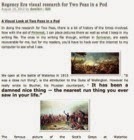 as well at Pinterest and a blog post here.
as well at Pinterest and a blog post here.



